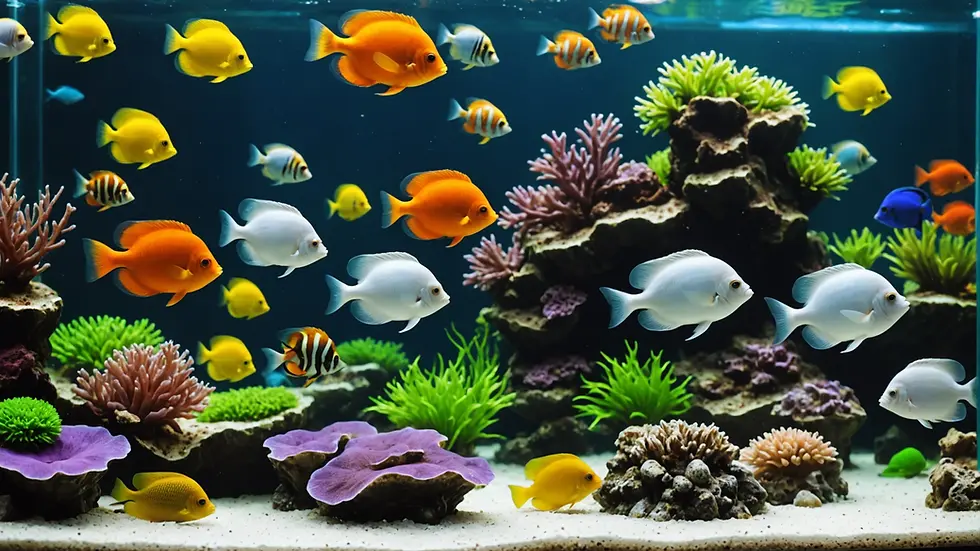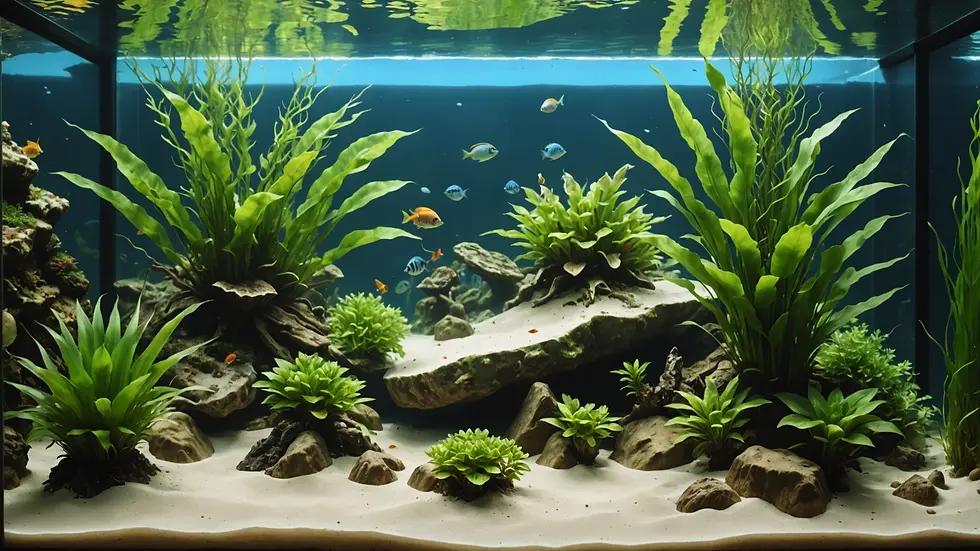Why Are Aquarium Substrates So Diverse and Varied?
- Jyotiraj Borah
- Feb 6
- 4 min read
Aquarium substrates form the base of a flourishing underwater habitat. They not only define the visual appeal of a fish tank but also play a crucial role in the health and happiness of its aquatic residents. With so many choices available, it’s worth exploring why aquarium substrates differ so much. This article will explore the various types of aquarium substrates, their functions, and the characteristics that make them unique.
Understanding Aquarium Substrate
Aquarium substrate refers to the material placed at the bottom of the tank. It is vital for creating a healthy aquatic environment. Selecting the right substrate requires considering the type of aquarium, the types of fish or plants that will be housed, and your visual preferences.
Substrates impact water chemistry, plant growth, and the biological balance of the aquarium. Thus, grasping the various options is essential for anyone passionate about aquariums.
Types of Aquarium Substrates
1. Gravel
Gravel remains one of the most popular substrates among fish keepers. Available in a range of sizes and colors, it offers versatility and ease of maintenance. Made from natural stones or synthetic materials, gravel allows for good drainage and supports plant roots effectively.
Because it is porous, gravel provides a habitat for beneficial bacteria that assist in biological filtration. For example, using 1 to 2 inches of gravel can provide adequate space for bacteria to thrive. However, gravel can collect debris, leading to diminished water quality, which means regular cleaning is necessary.
2. Sand
Sand is becoming increasingly favored, especially for species like catfish or loaches that prefer a sandy bottom. A fine layer of sand creates a more natural setting for these bottom-dwellers and encourages the growth of rooted plants.
While sand looks visually appealing and mimics natural habitats, it can compact easily, which might obstruct water flow. Maintaining proper water circulation is crucial; a common practice involves lightly stirring the sand during routine cleanings to prevent anaerobic pockets from forming.
3. Soil-Based Substrates
Ideal for planted tanks, soil-based substrates are rich in nutrients that foster plant growth. These substrates often contain organic materials that enhance water quality and support lush plant life. For instance, using soil specifically designed for aquariums can lead to 20% to 50% faster plant growth compared to traditional gravel.
However, soil can leach excess nutrients into the water, potentially causing algae blooms if not monitored. It's vital to select the right soil for the target plant species and to keep an eye on nutrient levels.
4. Clay
Clay substrates are particularly beneficial for aquarists focusing on planted tanks. They provide essential nutrients for robust plant growth and often release beneficial minerals into the water.
While clay can cloud water right after being added, the long-term benefits usually outweigh this short-term setback. For example, well-managed clay substrates can enhance water clarity and promote healthier plant roots over time.
5. Synthetic Substrates
Synthetic substrates provide a modern, low-maintenance option. Made from plastic materials, these substrates offer a clean, uniform look and do not decompose.
While they are easy to clean and do not provide nutrients, this can also be a drawback for certain setups. Aquarists need to conduct more frequent water quality checks since synthetic substrates do not support beneficial bacteria as effectively as natural ones.
6. Crushed Coral and Aragonite
These substrates are suitable for marine and brackish tanks, as they help maintain a higher pH. Crushed coral and aragonite release calcium carbonate, making them ideal for fish species needing alkaline environments.
However, they may not be the best choice for freshwater ecosystems where fish prefer softer, more acidic waters. It's crucial to understand your aquatic residents' needs when selecting these options.
7. Peat and Organic Substrates
Peat is prized for its natural ability to lower pH, making it perfect for softwater aquariums. This type of substrate supports fish species that thrive in acidic environments, promoting a well-balanced biological system.
However, peat can decompose, releasing tannins that may discolor the water. Regular water changes may be necessary to keep the tank clear and healthy.
Image Placeholder

Factors Influencing Substrate Choice
1. Fish and Plant Species
Choosing the right substrate is often based on the species living in the aquarium. For example, a tank with bottom-dwelling species like corydoras catfish may benefit from a soft sand substrate. Meanwhile, heavy root feeders, such as Amazon swords, will thrive better in nutrient-rich soils.
Tailoring substrate selection to meet the specific needs of your species promotes a thriving ecosystem.
2. pH and Water Chemistry
Substrates have varying impacts on pH and overall water chemistry. Crushed coral can raise pH levels, offering ideal conditions for certain marine species, whereas peat is great for softwater fish due to its ability to lower pH.
Understanding these relationships is essential for creating suitable environments for your aquatic pets.
3. Maintenance Requirements
Each substrate type comes with distinct maintenance demands. While gravel may require frequent cleaning to remove waste, sand can compact, needing careful handling during maintenance.
Assessing your commitment to maintaining the substrate will provide a clearer picture of which option is best for your aquarium.
The Advantages of Diverse Substrate Options
Encouraging Biodiversity
The different habitats created by various substrates lead to a wider range of species within the aquarium. This diversity fosters a more balanced ecosystem, enhancing the overall health and stability of the aquarium.
Customization Possibilities
The selection of substrates allows hobbyists to express their creativity. Options range from vibrant colors to natural textures, enabling a personalized aquarium design. A well-placed substrate can transform a basic tank into a stunning centerpiece.
Supporting Natural Behaviors
Diverse substrates help mimic natural environments, promoting healthy, instinctual behaviors among fish and plants. For example, bottom-dwelling species can sift through soft sand, while rooted plants find stability and nutrients in rich soil.
Final Thoughts
Aquarium substrates do more than enhance appearance; they are critical to the overall health and stability of the ecosystem. With such a variety of substrate choices available, aquarists can create unique aquascapes tailored to meet the needs of their fish and plants.
Understanding the functions and characteristics of each substrate type empowers hobbyists to make informed decisions, ensuring their aquarium flourishes. A well-chosen substrate can elevate your aquarium experience and deepen your connection to the fascinating world of aquatic life.
Image Placeholder

Image Placeholder





Comments